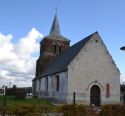The artistic heritage of the monks of Wisques 3
This tour will allow you to discover a unique regional art, produced by monk artists from the first part of the 20th century. You will appreciate the unspoilt landscapes of the Blequin and Aa valleys. Between Wisques and Leulinghem, you can see the old cathedral of Saint-Omer. A journey combining nature and culture, to be done with the family.
-
Abbey von Wisques
This young abbey, at the instigation of Father Savaton, has been able to attract talents who have artistically shaped this amazing place and the surrounding churches. In the 1930s, Dom Paul Bellot, a monk architect, built the new building adjoining the original "great castle" and including the refectory, two floors of cells and the magnificent cloister gallery. In 1946, the Monastic Art Workshops were created, bringing together a group of artist monks:
Father Bouton (1914 - 1980) ceramic designer, Father Goossens (1910 - 1976) architect, Father Rousse (1932 - 1978) poet, Father Houssain (-) liturgical draftsman and Father Cholewka (born 1922) glass master as well as Brother François Mes (1892 - 1983) painter.
-
Notre-Dame de la Garde
Renovated in 2011, this chapel is representative of the monastery's artistic creation, combining the characteristic brick architecture of Joseph Philippe (a student of Dom Bellot) with the art of ceramic drawing by Dom Bouton.
-
Saint-Folquin Church, hamlet of Cormette
In the charming church of the hamlet of Cormette, you will find in the choir; on the diaphragm arch, frescos representing the worshipping angels. They were painted by François Mes, monk of the abbey of Wisques.
-
Saint-Omer Church of Zudausques
In this church, you will recognize the works of the monks of Wisques: the furniture used for the liturgy (the pulpit to be preached, the communion bench, the altar, the baptistery, the statue displays) is the work of Joseph Philippe, a student of Dom Bellot; a painting represents a pieta: the Virgin Mary crying for her son on her lap just after his death by crucifixion. Mary is helped by two angels who support the body of Christ. This work is located on a side altar commemorating the dead of the town during the two world wars. The author of this work, Father Mes, is easily identifiable because he uses shimmering colours with a dominant blue colour.



